The White Book of Sarnen
The White Book of Sarnen
The White Book of Sarnen
The White Book of Sarnen is regarded as the most important source for the history of the Swiss Confederation. The book was written by the Obwaldner Landschreiber Hans Schriber between 1470 and 1474. The White Book contains copies of the most important treaties, alliances and decisions relating to the «Unterwalden over the woods». Only on pages 444-465 of the more than 500 pages follows the part that makes the book unique from today’s point of view: the oldest account of the founding of the Swiss Confederation and the liberation of the forest site from Habsburg’s tyranny.
Justice
Justice
Justice
Anyone who has ever stood in front of the Sarner town hall probably saw the pillory, the pillar with the necklace. The wooden block with the four leg openings, the so-called stick, had the same function. The court sentenced people, especially for slander and defamation, but also for idleness, to stand in a public square in desecration or to sit in a stockade. Quarrelsome women had to wear the «quarrel violin», the wooden device shaped like a violin. The fire irons were used to brand thieves.
The pointing sword and the portrait of the executioner Johann Jakob Volmar remind us that the death penalty was only abolished throughout Switzerland in 1942. The last civilian execution in Switzerland was carried out in 1940 in Sarnen.
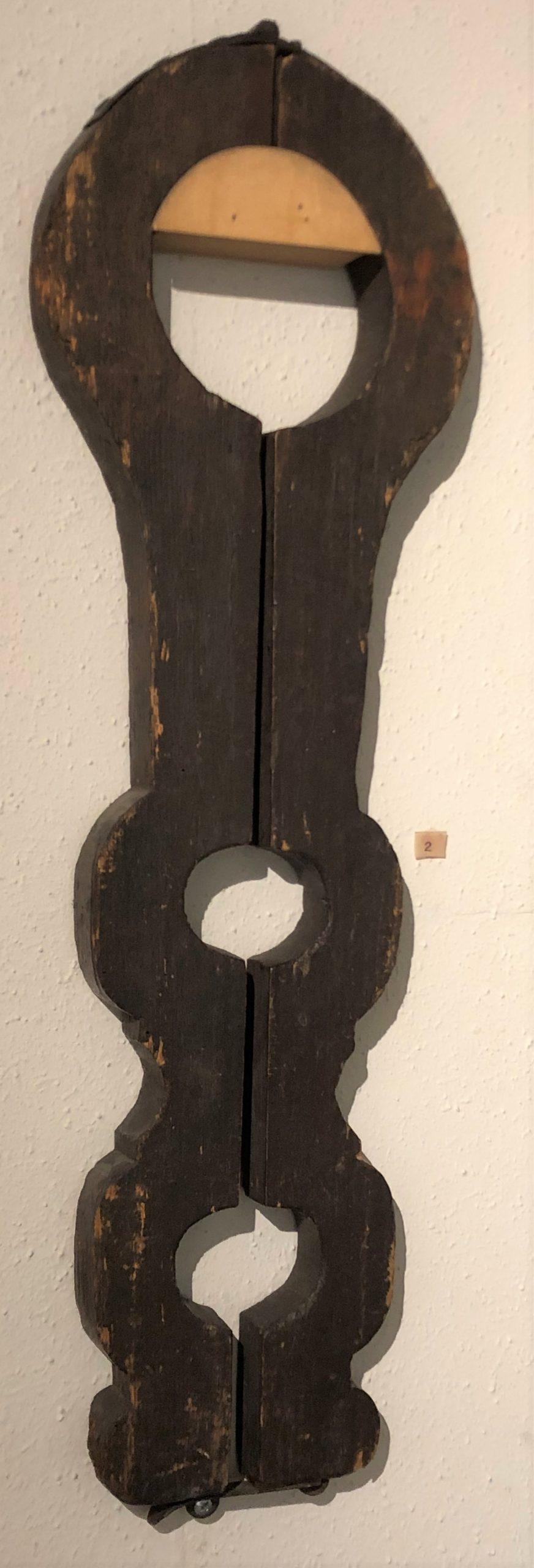
Seals and medals
Seals and medals
Seals and medals
Some seal stamps as well as seals are shown in this showcase. The two oldest seals of Obwalden are kept in the State Archives. The seals here were in use shortly before Helvetic until around 1800. Some private seals can also be seen here.
Each Landammann had to have his own personal stamp to seal letters, guilds and other documents.
In the same showcase there is also a collection of medals that the State had minted in honour of Brother Klaus. The oldest piece, a silver medal by the Zurich medallist Jakob Stampfer from 1550, was made only about sixty years after the saint’s death
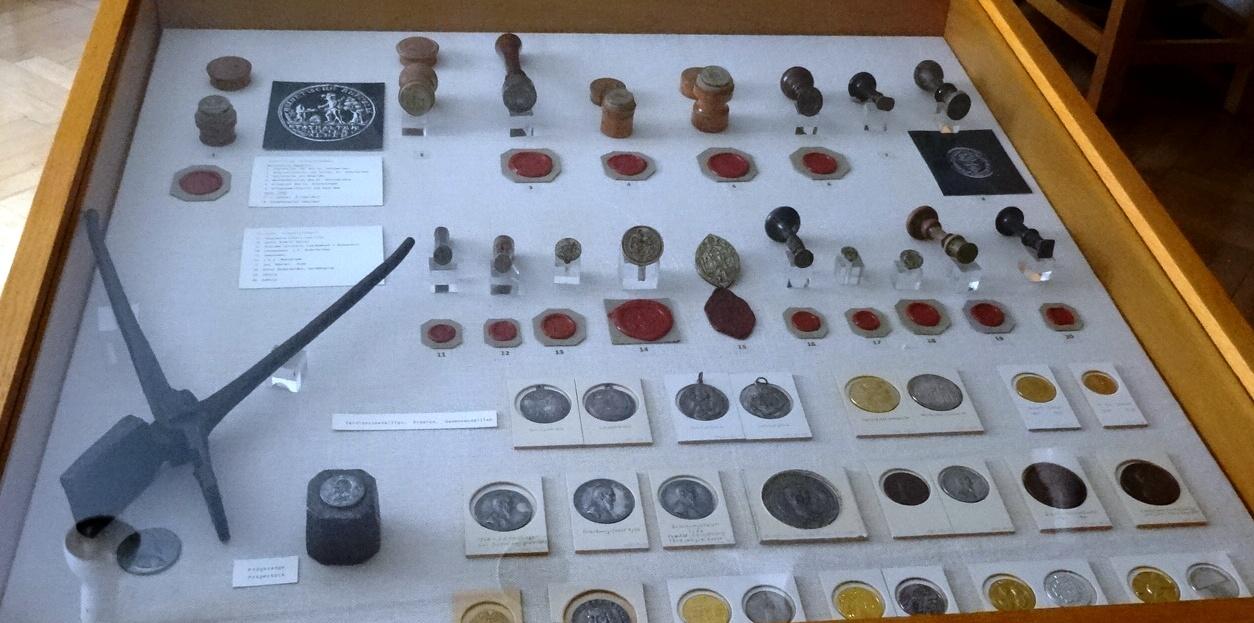
Lenght and hollow mass
Lenght and hollow mass
Lenght and hollow mass
Before the introduction of the current metric mass like kilograms, liters, meters, etc., different masses were used in Switzerland, e. g. pounds, mass, and ul. These were not the same in every canton, even if they had the same name.
On the wall to the left of the display case is the large Elle, the so-called «Mother Elle». This original measure was placed outside the town hall, so that everyone could calibrate their own measuring instrument and check whether they had received the correct measure. Inside the showcase, you can see a few scales and weights they used back in the days. The picture in the background shows the Sarner village square with the town hall. It was designed by David Alois Schmid (1791-1861).
Postal history
Postal history
Postal history
In the center of the showcase is the old Postbrente of Sarnen, it is also depicted on the 10-series Pro Juventute stamp from 1975. With the Brente, the Postman used to pick up the mail for Sarnen, once a week in Lucerne and in Stans.
The inn „Zum Posthorn“ existed until 1882. It housed the first post office in Sarnen. The letters in the display case to the right were written by Wilhelm Britschgi (1836 – 1925), a postman from Kern in Germany. A rarity is also the Sachsel postmark, dedicated to the «Centre of Switzerland» on the Älggialp and in use from 9 September 1999 until the closure of the Sachseln post office on 5 April 2019.
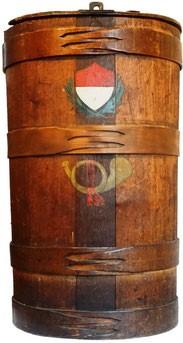
Traditional officer costumes
Traditional officer costumes
Traditional officer costumes
Two traditional official costumes are exhibited here, those were worn by the Landrunner and the Landhelmiblaser. The runner was the messenger of the government. He also had to accompany prisoners to interrogations.
The Helmiblaser accompanied the Landammann with the big horn, which is called the Helmi. On important occasions, e. g. to the local community. On the ground there is an 18th century land book containing the laws of the canton.
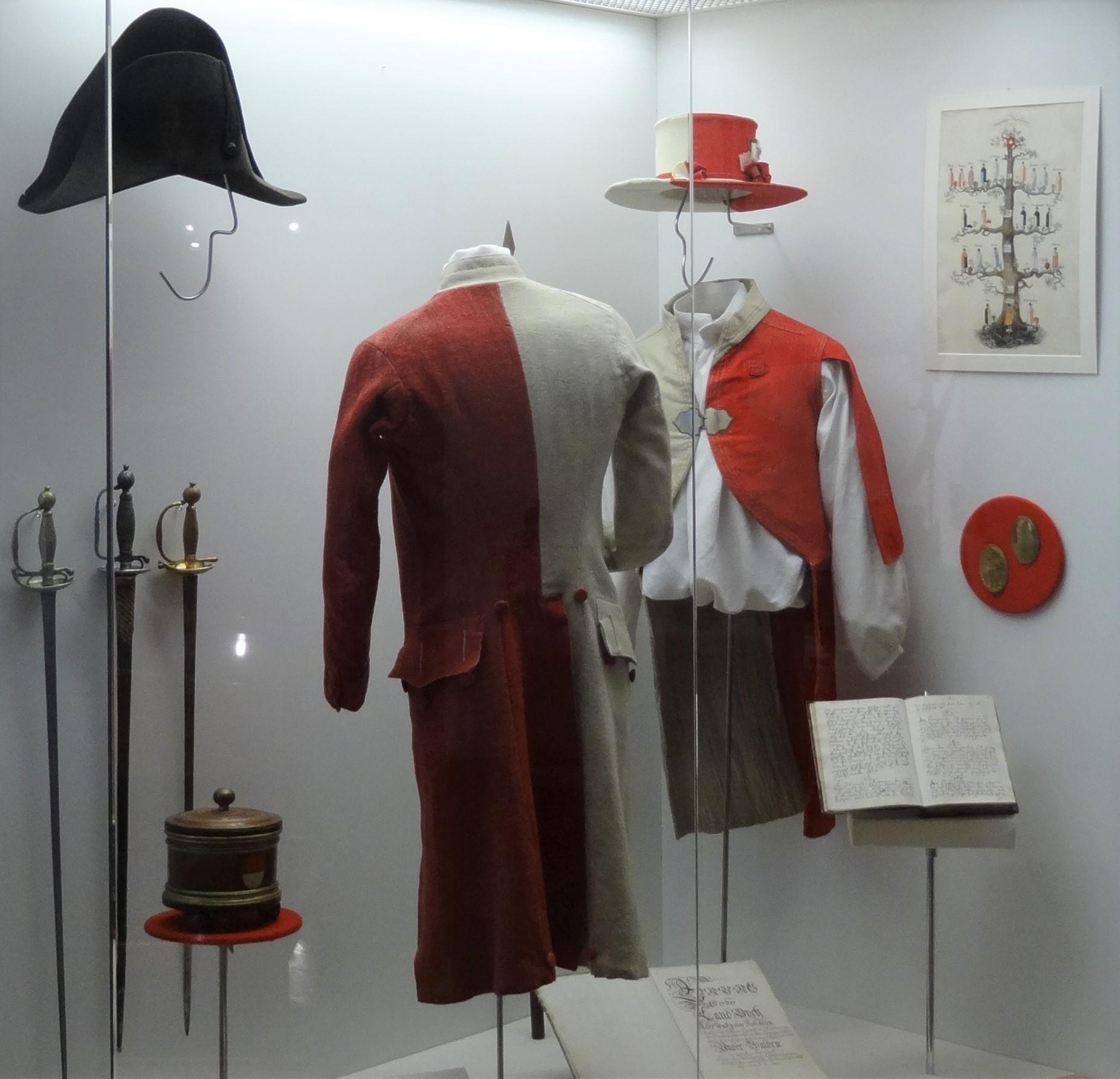
Money
Money
Money
Until 1850, each canton had its own coins. Obwalden had gold coins (ducats), silver coins (thaler and halbtaler) and many cruisers minted between 1725 and 1745. They were in circulation from the 18th century to about 1850.
After the founding of the state in 1848, the introduction of a single currency proved necessary. Of these Swiss francs, we have a first Swiss coin with the sitting Helvetia. Special exhibits include banknotes printed by the Obwaldner Kantonalbank from 1886. After 1907, the Swiss National Bank became the central bank responsible for the banknotes. All other banks had to stop the banknote business.
Also interesting is the so-called «money cat», a kind of giant leather wallet that cattle traders strapped around their stomachs when they did business abroad.

Salt scale
Salt scale
Salt scale
In the corner next to the passage to the next room hangs the salt scale. It is a magnificent work of art and craft from 1664 and comes from the town hall, where the salt trade took place on the ground floor and where the official butcher shop was.
In the display case under the scale are common weight stones from Obwalden
Juliusbanner
Juliusbanner
Juliusbanner
The rear room is dominated by the Julius Banner, a showpiece of the museum. Pope Julius II gave it to the Underwalders in 1512. In the same year, federal mercenaries fought for the Pope in the Pavier campaign against the French and won the victory. The banner is made of red and white Milanese silk damask. The Holy Father. Peter with the keys dominates the banner. The Key of Petri still forms the coat of arms of Ob- and Nidwalden. This precious flag was carried to the parish until 1929 as a symbol of the papal blessing. To the right of the Julius banner stands a chest from about 1520. The front and the two sides are carved ornamentally. On the front, birds tease an owl. On the left side of the Juliusbanner, there is a glass painting in the windowand it’s a work by Anton Schiterberg. The red-white shield, which stands for Unterwalden, is depicted, surmounted by imperial coat of arms and crown. Beside the Unterwaldner banner carrier with the flag. In the zigzag we see an early depiction of Brother Klaus.
Painted chest
Painted chest
Painted chest
On the floor below the window is a wooden chest with the coat of arms of the Imfeld family on the high lid and a lettering: “Herr Landvogt Imfeld”.
Until 1798, the municipalities (cantons) involved in a common domain (subordinate territory of the Swiss Confederation) appointed a Landvogt to lead the administration and exercise jurisdiction. After two years he was replaced on a regular basis by a governor from one of the other places.
Music
Music
Music
The musical instruments on the right side are all from the Kerns Musikgesellschaft, as shown by the Kerns coat of arms on the drum. Decorative and original is the „Schellenbaum“, which was created in Sarnen around 1830, with which the time is indicated. The crescent at the top indicates its origin from the Ottoman Empire, hence its former name „Turkish Hat“.
Much smaller musical instruments can be seen in the display case: harps, also called „Trümpi“, from the 19th century. The instrument was popular in German-speaking countries, especially in folk music, and was already widespread in the Middle Ages.
Playing the piano belonged in the 19th century. for the formation of the «Higher Daughters».
The paintings above the piano show Nikodem Krummenacher (1807 – 1887), organist in Sachseln and his wife Theresia Rohrer (1806 – 1864).
The undated self-portrait of Theodor von Deschwanden (1826 – 1861) shows: He was a gifted painter – and unfortunately conceals that he was also an excellent musician.
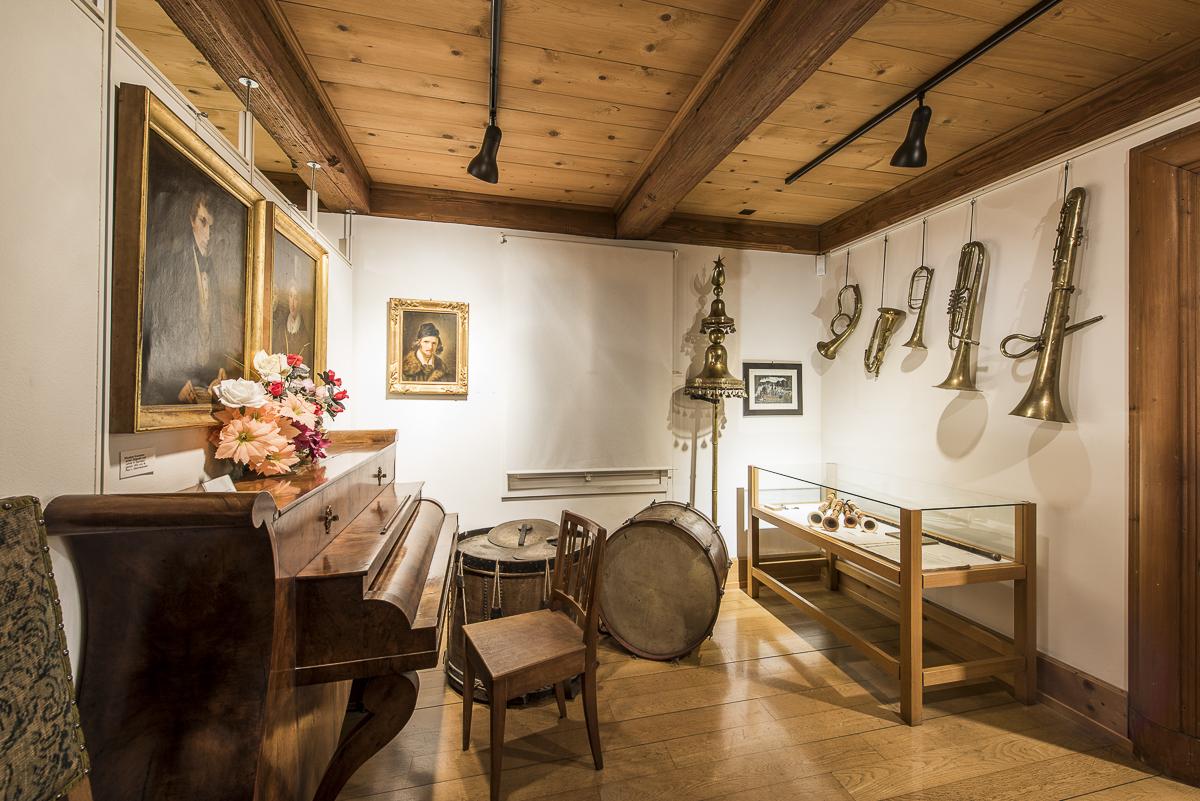
Handwork
Handwork
Handwork
The middle table display case is dedicated to manual work. However, embroidery and ironing, formed only a small part of women’s work. Clothing as ready-made, i. e. industrially produced, did not appear on the market until around 1850.
Household
Household
Household
Another craft, glass-making, was native to Flühli, in the nearby Entlebuch. His products were also popular here. In the display case on the right are some velvet glasses on display. In the same display case is the Spanish soup bowl. A stew, the Olla Potrida, was cooked in the oven, while the family attended Mass on Sunday.
Only the rich could afford the bronze pot: the bowl was an expensive prestige object, cast in the cannon and bell foundry Füssli in Zurich. The initials N and W above the coat of arms of the Wirz family name Niklaus Wirz, Landammann from 1545 to 1550.
Straw processing
Straw processing
Straw processing
Already in the 19th century. straw processing had an important economic importance for Obwalden. In addition to working in the „Hüetli“, the factory in Sarnen, the „Hüetlä“ in homework was an important secondary income in times of great poverty. The «Röhrlihüte», are hats made from whole, unflattened straws were exported as far as America.
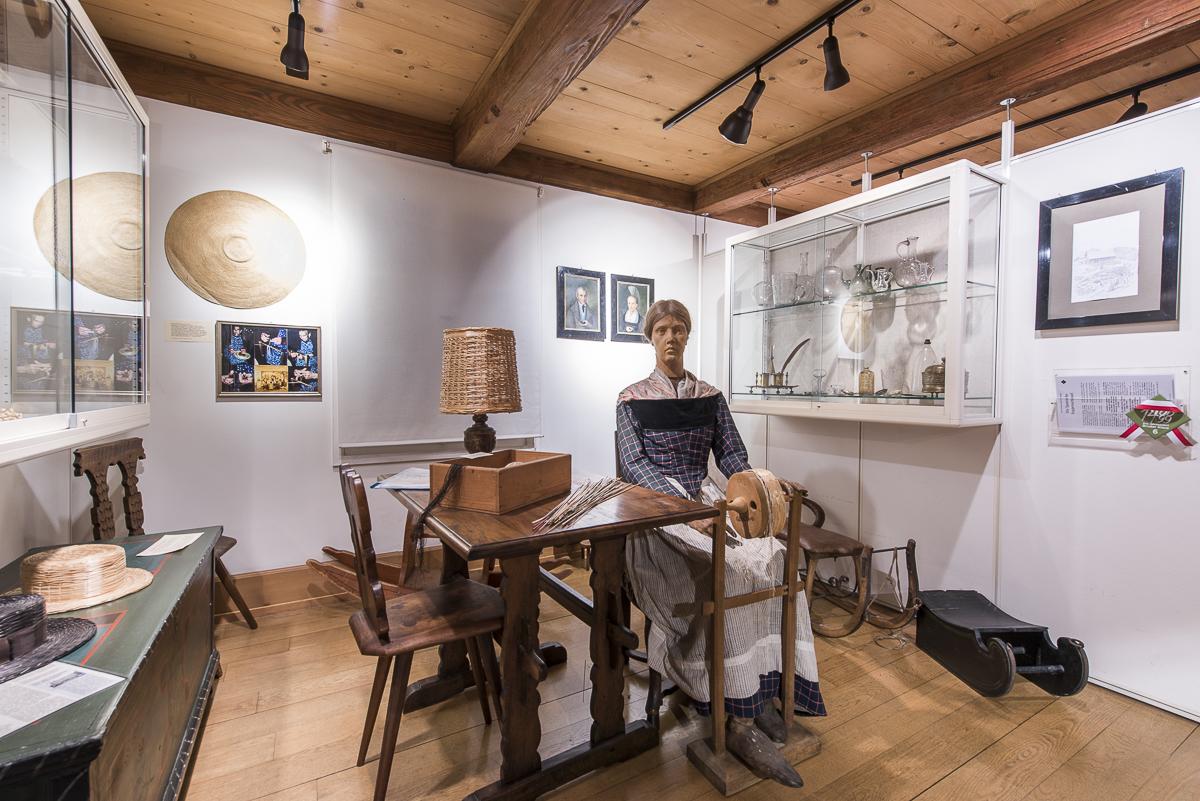
Fire and light
Fire and light
Fire and light
Before the invention of electricity, candles, kerosene and oil lamps were the only sources of light. The scissors with the box-like structure served to shorten the candle holder. The gun-like device is a lighter: When flint and metal collide, a spark is created that ignites easily glowable material inside.
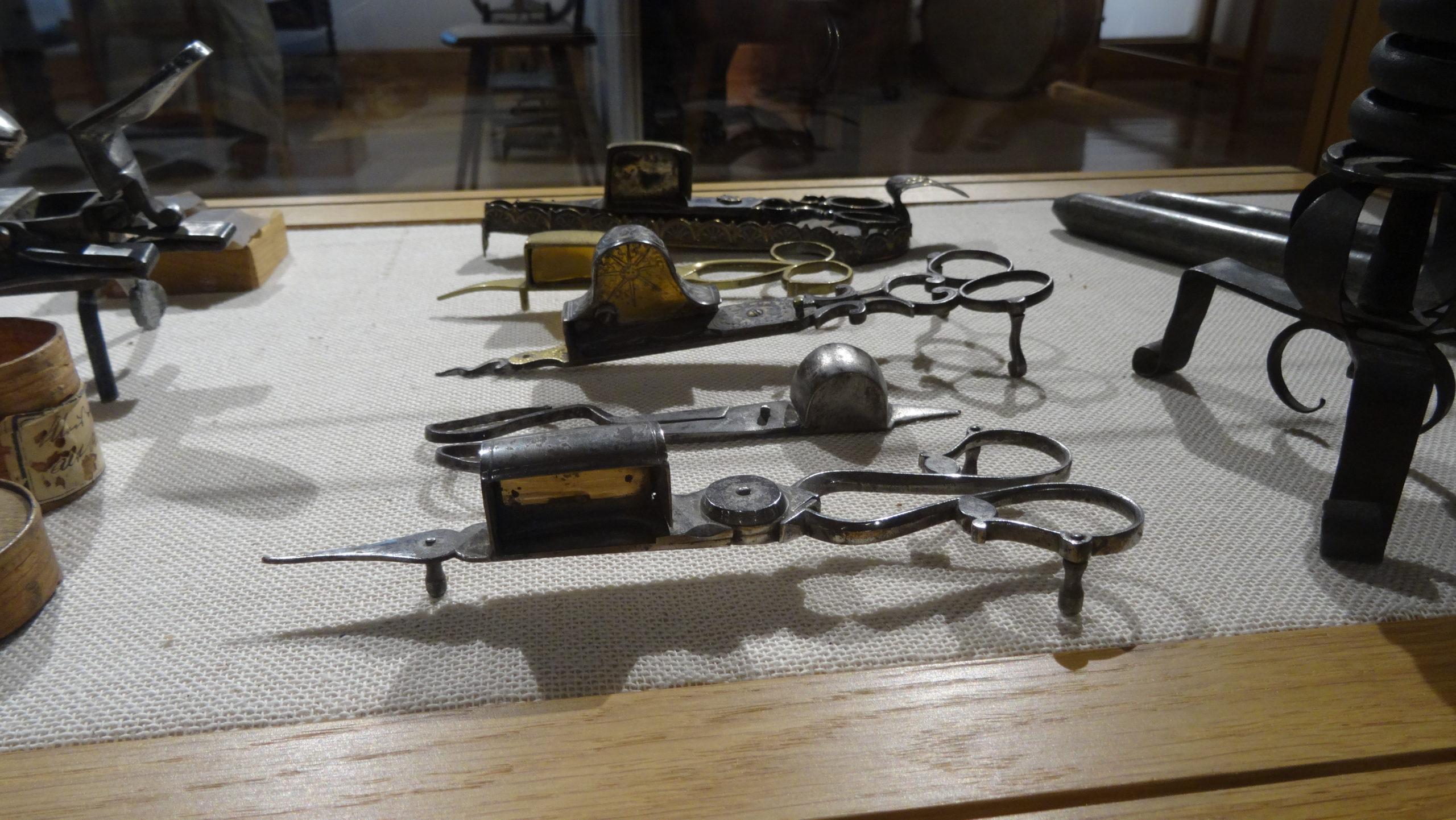
Clocks
Clocks
Clocks
Clocks dominate the niche in front of the living room. Particularly striking is the mighty clockwork from the Ramersberg St. Wendelin Chapel. It dates back to the 17th century.
A rarity is the iron clock on the wall, a work of the Sarner clockmaker Viktor Kieser from 1585.
The woodwork clock with the crowned head also comes from the interior of Switzerland. Since its lower jaw moves at the stroke of the hour, this clock is also called „Zeitbeisser“. Franz August Schulthess (1660-1745) of Schwyz made it in 1722.
Also noteworthy is the large sundial, which is not here, but in the anteroom with the «White Book». It originally adorned the garden of the Capuchin monastery Sarnen (today: seniors‘ residence «Am Schärme») and was built in 1657.
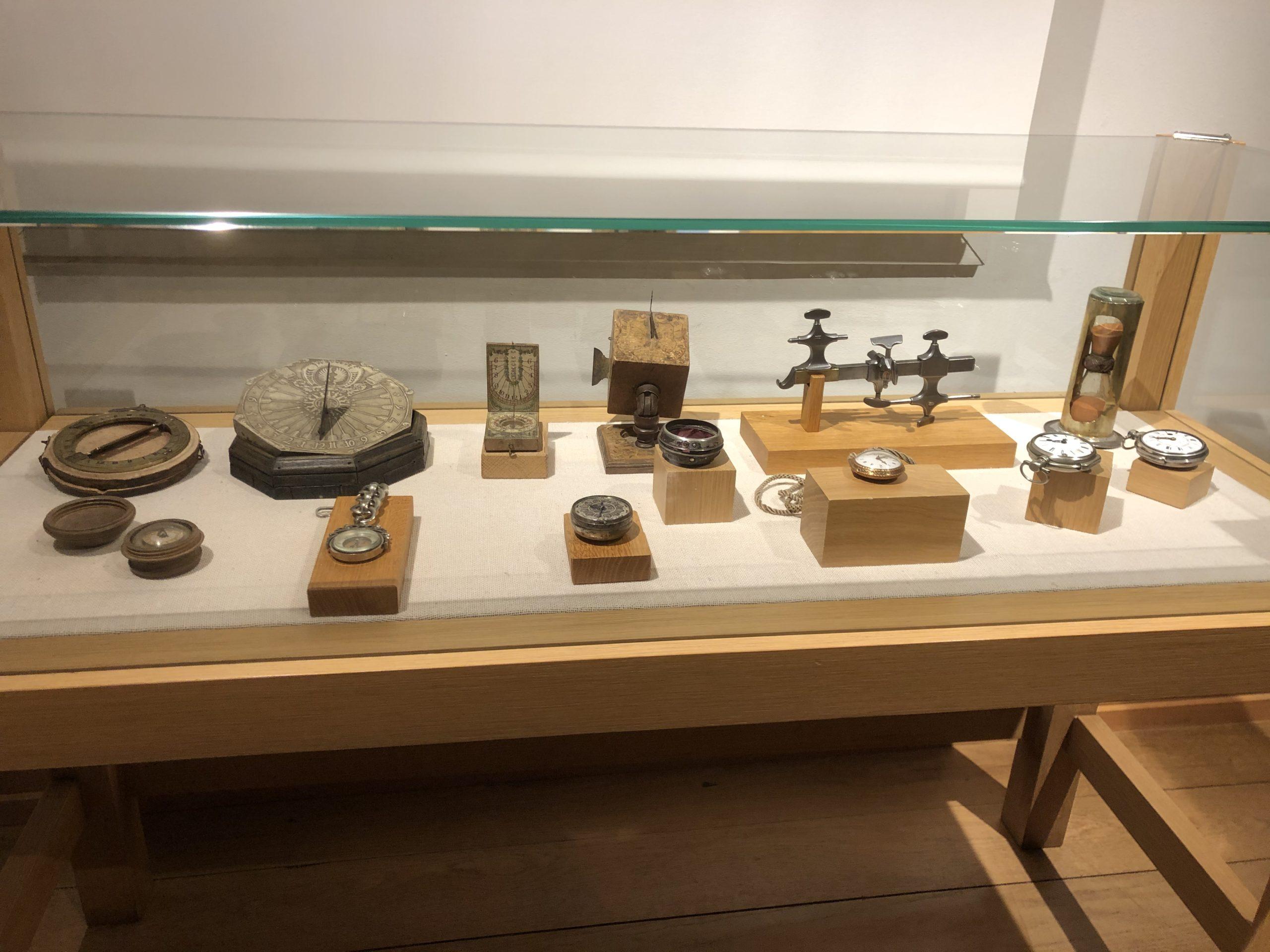
Türliroom
Türliroom
Türliroom
Most of the furnishings of this stately parlour come from the „Türlihaus“. Marquard Imfeld had it built around 1630 near today’s Sarnen station. It was demolished in 1950. The furniture – with the exception of the corner cabinet – was part of the furnishings and dates back to the construction period. The oven is a work of the Lucerne Hafner family Küchler.
The paintings show members of the economically and politically powerful Imfeld family. This is particularly evident in the portraits painted around 1747 of state ensign and captain Felix Imfeld (1713 – 1763) and his wife Anna Maria Stockmann (1721).
An Imfeld is also depicted on the picture to the right of the furnace: Niklaus Imfeld, abbot of the Einsiedeln monastery from 1734 to 1773. As the builder, he decisively shaped the present appearance of the monastery and its grounds.
Portraits
Portraits
Portraits
The portraits are by Franz Andreas Heymann (1798-1873). With his naive and precise way of painting down to the last detail, he achieves revealing portraits of people. He often portrayed them against the background of their world of life or social position.
Among the Heymann portraits is another chest with the coats of arms of the Imfeld and Jakob families, dating from around 1680. The initials name the owners, the couple: Johann Franz Imfeld, Weibel – Frau Maria Anna Jakob.
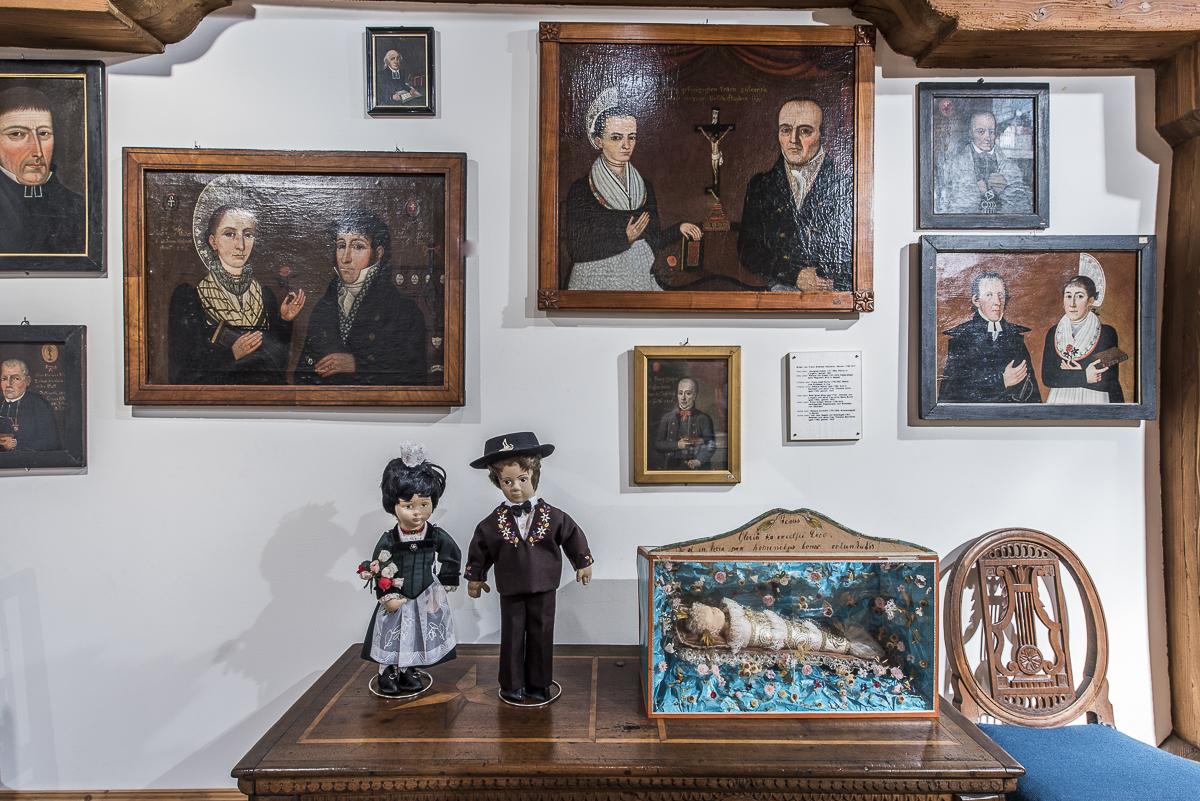
Traditional jewelry
Traditional jewelry
Traditional Jewelry
Jewellery can be seen in the display case in the middle of the room. The Obwalden women wear the hair arrow or hair spoon, the hair ornament of the singles, and the „halsbätti“. This necklace consisted first of coral and later of dark red garnet stones.

Gute Stube
Gute Stube
Gute Stube
The buffet from the middle of the 18th century. with the flat carved ornaments comes from Ramersberg ob Sarnen.
The magnificent stove with relief tiles from about 1630 was originally larger. Twice it was dismantled by a Hafner and re-installed with the tiles that were still usable as a smaller stove. In addition to biblical representations, the tiles also show the main virtues and musical motifs.
The seated woman wears a dress that according to the fabric used was made after 1800. Her hood, a so-called „Schynhuibe“, shows that she is married.
The woman on the right is dressed in the rural fashion of the early 19th century. The hairstyle with the white braids and the hair arrow signals: She is single.
The girl wears a checkered „heuerkraut“, a work dress.
The clothes of the three women do not correspond to today’s Obwalden costumes. These were created in the 1920s after old models. Dresses like the ones shown here, but also portraits and engravings (see opposite wall) were consulted to create a typical regional costume. The dolls wear today’s costumes
Handicrafts in the house
Handicrafts in the house
Handicrafts in the house
Tin vessels were to be found in almost every household, more or less elaborately designed depending on wealth. Two local tin founders worked in Obwalden: Hans Josef Ettlin (born in 1721) and his son Franz Xaver (born 1756). Often mermaids crown their works.
The tin casks belong in the niches of the buffets, including a small tub. If you want to wash your hands, open the small faucet, the water flows out.
Tile stoves finally prevailed in Obwalden in the 16th century. Manufacturing of tiles and furnaces it is necessary for specialists, hawkers, to do the work. The most famous Hafner family in Obwald is the Dillier family, which still manufactures ovens today. Master Heinrich Dillier signed the kiln crown, dated 1812, with M. H. D.
The chest is probably the oldest storage and transport furniture. The museum shows in the first and 2nd floor different types. This one dates from around 1720 and shows the Imfeld coat of arms on the lid.
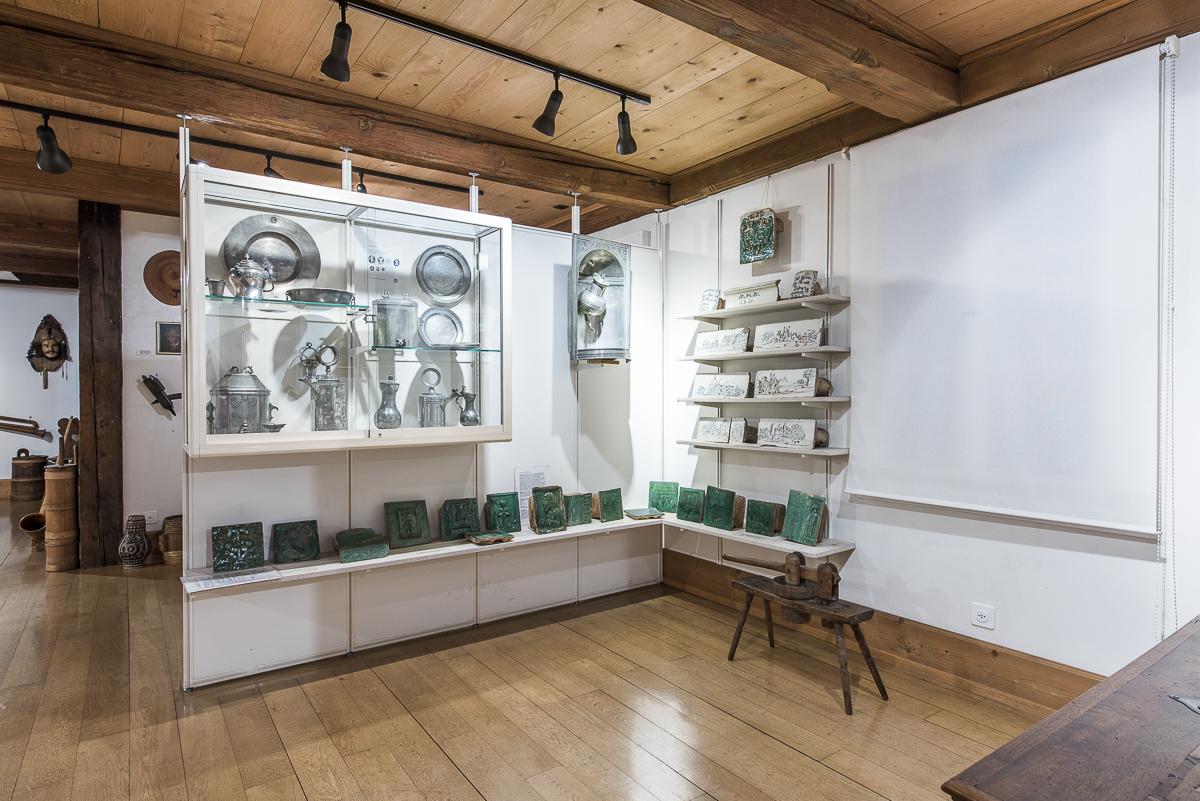
Handicrafts on the house
Handicrafts on the house
Handicrafts on the house
Typical of the old Obwalden houses are butted windows, framed by ornate facade boards. Windows with round butt panes of green forest glass have been around since the 15th century, lead ladders combine the round pieces of glass into windows. In order for the lead bars to have the correct slot width for the glass panes, they are pulled through the lead wire. The window with the six-sided panes comes from a house dated to 1820.
Until the 19th century. most houses had a flat roof with wooden shingles. A steep roof covered with bricks was reserved for the wealthy. This changed only around 1800 with the industrial production of bricks and nails. The bricks with religious motives are supposed to protect the house.
Obwaldner carpenters attached importance to artfully forged locks on doors and chests.
Everyday life of a Peasant
Everyday life of a Peasant
Everyday life of a Peasant
The large painting in the niche shows a grain fodder pulled by an ox on the Kernser Allmend. The picture reminds us that grain was once grown in our pre-alpine region for self-sufficiency. Cereal cultivation includes the threshing flax and the worfel, the braided tub underneath the painting, which is used to separate chaff and wheat. In addition, other farm tools.
The Kernser painter Karl Bucher (1819-1891), called „Zuber Karli“, captured everyday life in a number of paintings, such as the oxen team. His self-portrait and another picture with sheep are also hanging here.
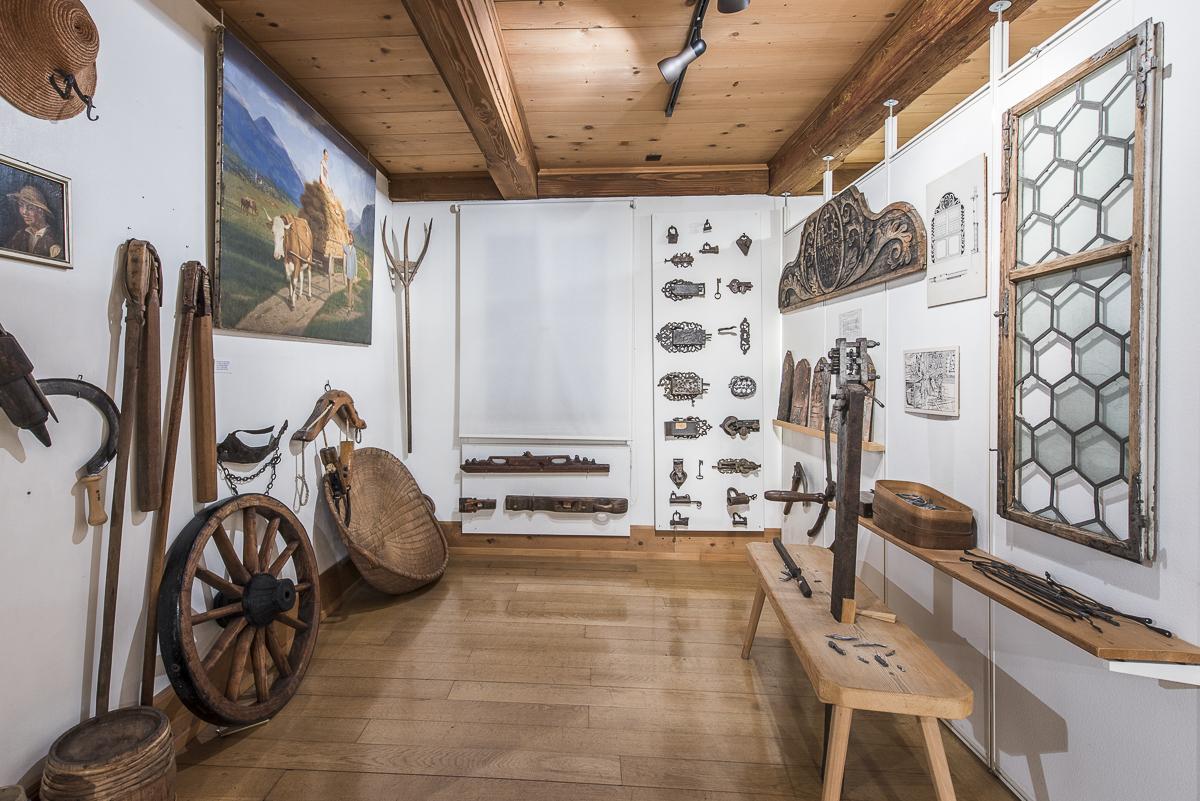
Alpine hut
Alpine hut
Alpine hut
The Alpine hut is a reconstruction. It shows what most alpine dairies looked like around 1900. Agriculture is still important for Obwalden today. Since the fertile valley soil is limited and necessary for the harvest of hay, the cattle spend the summer on the alp. The milk was processed into cheese, ciger and butter on each alp
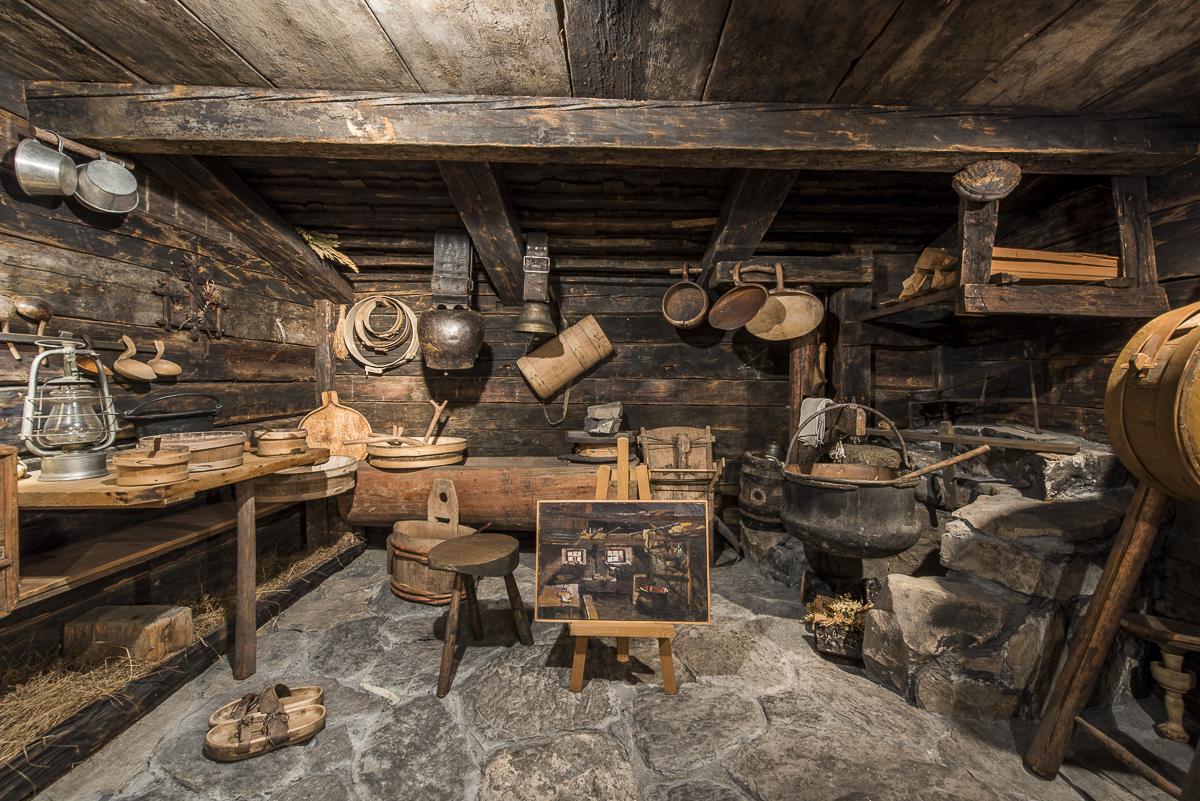
Büchel and Alphorn
Büchel and Alphorn
Büchel and Alphorn
Büchel and Alphorn have many things in common: Both are originally signal instruments of the herdsmen. Both are wind instruments without holes, valves or valves. Both sound only natural tones.
This bucket, actually a folded alphorn, was made around 1850.
People of the Wild
People of the Wild
People of the Wild
On the wall next to it hang two masks of the Wildman, the left from 1850, the right from 1750. In late autumn, the alpine people celebrate the alpine chilbi in every village, a celebration of thanks for the good course of the alpine summer. Wildman and Wildweib also perform at these festivals, have all kinds of fun and tell funny anecdotes in verse form. To the left of the two Wildman masks, there is the alpine Flag from Kerns, a town in Obwalden. On the Kernser Älpler flag of 1873 St. Wendelin embroidered in silk. This saint is the patron saint of farmers and livestock and is highly revered in the agricultural canton of Obwalden.
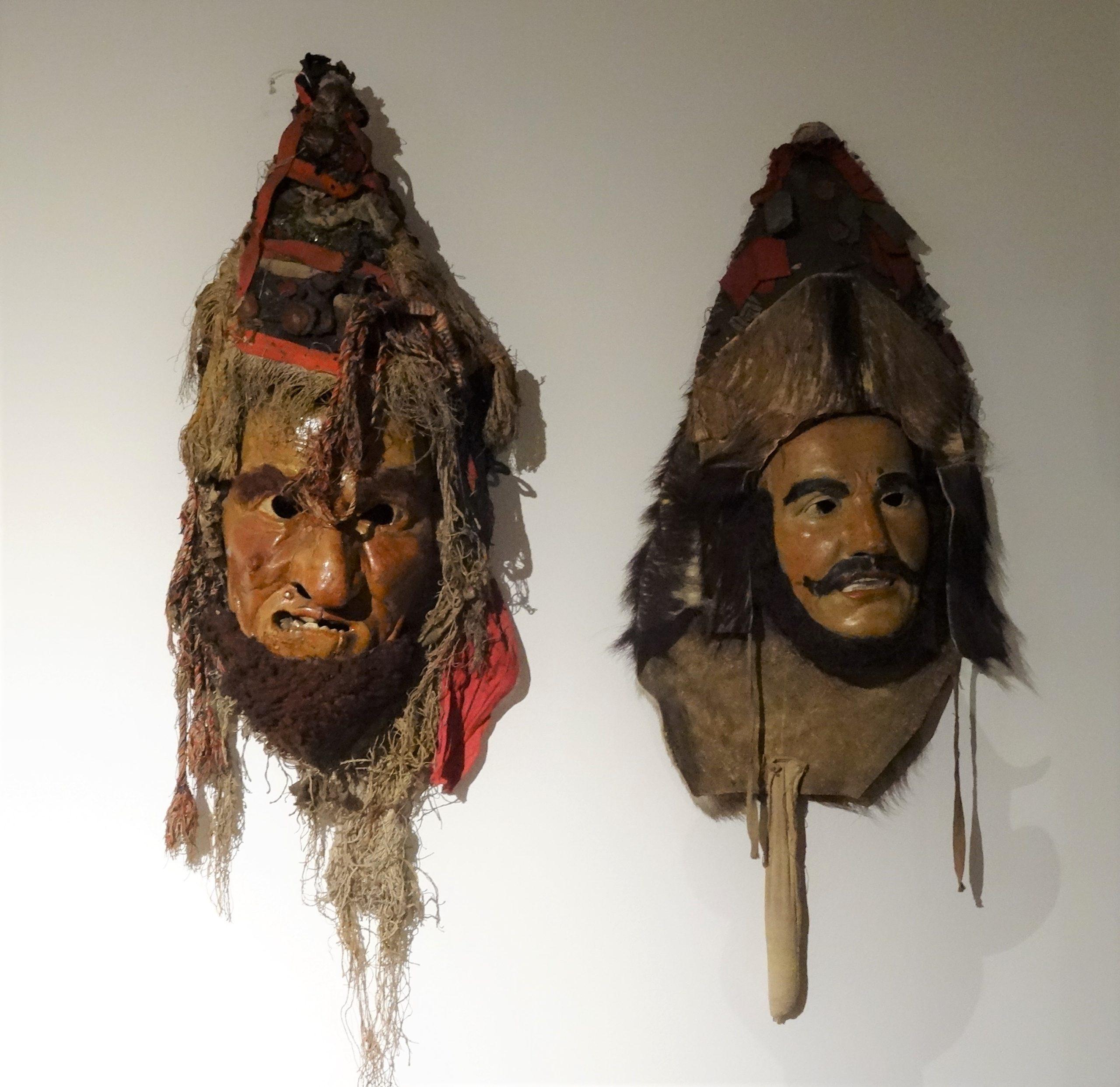
Muttelispiel
Muttelispiel
Muttelispiel
To the left of the Kernser Älpler Fläg there is the so-called „Muttelispiel. The symbols in the round fields are so-called „peasant numbers“, as they were still in use in some cases until the First World War. A single stroke means 1, a V is 5, a 0 or an X is 10. A horizontal stroke by a number multiplies its value ten times, for example III corresponds to 30. Like other games of chance, the muttelispiel was repeatedly banned and disappeared at the end of the 19th century.

